I continue to write, just not here
From about 2018 to 2020+ I stopped adding new articles to this personal blog in order to focus on MassLandlords and RentHelper. I may return to this blog in the future. For now, you can see updates at:
2018 Massachusetts Ballot Question One: Not Great Governance
This 2018 election, Massachusetts ballot Question One is about nurse-patient ratios. Specifically, they say there should only be so many patients assigned to a nurse, depending on how intensely the patients need help. Ballpark, this is a reasonable idea. The devil is in the details. The following is the summary of some emails I shared with my brother. The views here are my own.
Data on Massachusetts Ballot Question One
The only data I’ve seen on the subject for either side comes from the NIH. Their study addresses staffing ratios in terms of nurse hours, rather than nurse numbers, and looks at ACA penalties as a proxy for outcomes. The basic gist of the study is that medical centers with more nursing hours have fewer ACA penalties. We can therefore expect they have better patient outcomes. More nurse hours = better for patients. Makes sense.

The Loophole in Massachusetts Ballot Question One
The proposal as drafted has a theoretical loophole. As the ballot initiative concerns nurse numbers rather than hours, and the statute it modifies does not define a “registered nurse” as a full time equivalent, it leaves the law open for dodging.
Imagine I’m the Massachusetts Nursing Association’s hypothetical cost-cutting monster of a hospital administrator. I could meet the requirements of the proposed law by making all my nurses half-time and loading each up at the legal ratio. This would be effectively twice the intended capacity. Each nurse would each have the right number of patients, but they’d have half as many hours to offer care. The drafters of Massachusetts ballot Question One surely do not intend this. Unless there is a definition elsewhere that I haven’t read, this is the loophole they have written.
A Broken Public Discourse around Ballot Question One
I believe that the hospitals have a propaganda machine. So do the MNA. Both sides are using scare tactics, like hospitals shutting their doors and patients dying from neglect. I agree that there is a problem to be solved here. I would like to see this bill iterated on with comments from both sides, and taken up by the legislature. Ballot initiatives are not collaborative projects. Consensus ought to be possible between these two perspectives looking at the same patients.
In fact, with a few exceptions, ballot questions tend to cost at least a million dollars either side. Sometimes much less can get spent, like the repeal of the gas tax indexed to inflation ($100,000 to win; $500,000 to lose). The 2016 Charter schools question cost $6 million to win (and another $12 to lose). Final figures for 2018 Massachusetts Ballot Question One aren’t in, but both sides surely are invested in a victory. There’s no opportunity in the do-or-die ballot process to take criticism from both sides and craft a consensus bill.
Shouldn’t we at least try Massachusetts Ballot Question One?
I would be on board with trying new things. That’s not really the intent of the question, though. Forget the issue for the moment. Forget hospitals vs employees. Let’s think about how best to govern ourselves.
Imagine you were a democracy scientist and you wanted to “try” this. You would need:
- A control group;
- Data collection, both on outcomes and on the additional costs (you’re going to have more reports and inspections);
- A statically significant sample over time;
- A provision to stop if the experiment started harming people; and
- A mindset of “we’ll roll this back if it isn’t measurably better, net of costs”.
And probably you wouldn’t limit yourself to nurses, right? Maybe you’d include doctors and support staff in the study as well. Doctors and support staff can be just as overburdened, if not more so.
The question seems to start from an assumption that “more nurses is the right thing to do,” but given the polarization, I have to consider that there may not be consensus on this question.
Couple this with the theoretical loophole about head count vs hours, and I’m more concerned.
I’ll just point out one more thing: the fine print modifies the mission of the Health Policy Commission, which was intended to be about data, and grants it enforcement powers, like the Attorney General. This bill is so far removed from free inquiry about how best to govern ourselves that it dilutes the mission of a data gathering agency. It’s not a “let’s try it” kind of bill.
So for me, the devil is in the details. I think there hasn’t been enough conversation on this bill. And I for one would rather see more effort toward consensus on matters of life and death.
Consensus Decision Making in a Room of 19
I liked a recent experience on the City of Worcester’s Task Force for Sustaining Housing First Solutions. In the current climate of incivility, especially on social media, consensus-oriented approaches to hard problems are especially appealing. Here’s how this one worked.
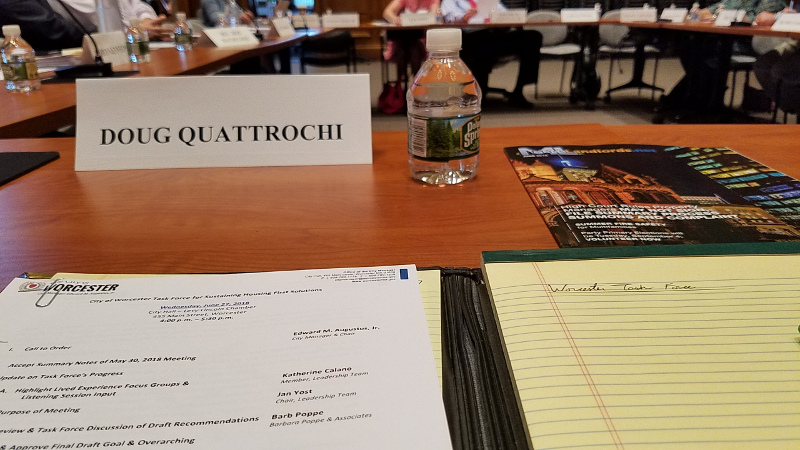
Smart editors, including Barbara Poppe, prepared a set of 26 recommendations. The goal was to have each of the 19 representatives around the room agree that their organizations would officially endorse the recommendations. Each recommendation would be read, and then each representative would give a thumbs up, a thumbs sideways, or a thumbs down.
Thumbs up meant your organization would endorse the recommendation as written.
Thumbs sideways was a request for floor time to ask a question. All questions were asked in series without answers so that commonality of questions could be identified. Then questions were addressed in bulk.
Thumbs down meant your organization would not endorse the recommendation. A thumbs down was expected to come with a proposal for alternate wording.
Results
In about 90 minutes, all 26 recommendations were reviewed and approved unanimously, several with extensive modifications.
Discussion
The thumbs up/down/sideways technique is notable for how it cuts away discussion about agreement. Oftentimes, volunteer (non-business) groups fall into a dynamic where one person states a shared principle or interest, and others take a long time agreeing or adding their own statements of shared interest. All of this is unnecessary in the context of a document that needs to be approved. The thumbs focused discussion on differences.
By being able to iterate on the text in the room, with most key stakeholders present, objections didn’t stop progress, get overruled, or result in a watered-down document. Instead, they resulted in recommendations that were both more concrete and also more widely supported. It’s hard to have people voting directly on complex issues, but iteration in this way seemed to make it work.
“Thumbs up” were the most common because a substantial amount of work had already been done on the text. We were voting paragraph by paragraph, which made each piece manageable.
“Thumbs sideways” were the second most common. Usually, participants asked their question, received clarification, and turned their vote to a “thumbs up.”
“Thumbs down” were rare. They did occur, most notably when Worcester City Councilor Konstantina Lukes expressed a strong desire for one recommendation to be issued with a “shall” instead of a “should” wording. Much discussion resulted, with the end result that Councilor Lukes gave a thumbs up without changing her insistence on the importance of “shall” and without the wording having been changed. It was a failure to reach consensus that we papered over.
This shows the trouble with strict or 100% consensus decision making approaches. Councilor Lukes held the power to scuttle the entire recommendation, or to present the entire document as non-unanimous. Instead of doing that, she conceded her point and went along with what was a clear majority. Perhaps some more work could have been done to address Councilor Lukes’ concern, or to formally note the concern in the official recommendation.
Besides this last issue, it was a good process. There was official consensus on all 26 points, and true consensus on 25 points. It felt efficient. It felt that all voices were heard. It has certainly produced a better result than simple majority rule would have. I hope to use the technique in the future.
Task and Management Update
I haven’t written a blog article in about seven months. It has been about a year since I optimistically wrote “The Great Untasking“. Here’s an update of that graph. Big-picture, little has changed:
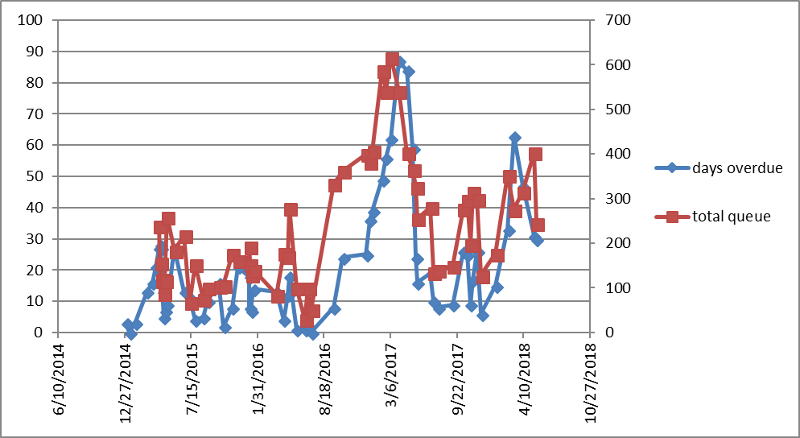
The “total queue” seems to be on average 280 items. “Days overdue” seems to be on average a month. Both series are structurally higher than prior to our first full-time hire in late 2016. This hire, which was the cause of so much optimism, gradually reduced their full-time hours until finally they went on full-time leave. This was for personal reasons, and we don’t begrudge them it. I was too cautious/optimistic in waiting for their bandwidth to return; MassLandlords should have re-hired much sooner.
We hired that one person full time before we should have. A single full-time hire leaves one vulnerable to changing bandwidth and personal circumstance. We have since hired four part-time people to replace the one on leave, and have been cross-training them in essential operations. We are now more immune to key personnel departures.
Despite the graph moving in the wrong direction, there are reasons to be optimistic. The new hiring process we used successfully identified new team members with the right skills, and took very little of our time. For the first time, I perceive my personal inbox to no longer be growing even with minimal attention. At time of writing, the inbox represents 188 items and 32 days’ worth of queue, no small percentage of the above backlog. So any day now, when I process that inbox down, we may realize what becomes a new structural low.
Types of Work
This graph shows the types of activities where I spend my time. There are three possibilities:
- Individual contributor (IC; I am doing work that theoretically could be hired for)
- Leveraged management (LM; I am working with or specifically to enable another team member)
- Strategy and analysis (SA; I am stepping back to think about what is happening or should happen)
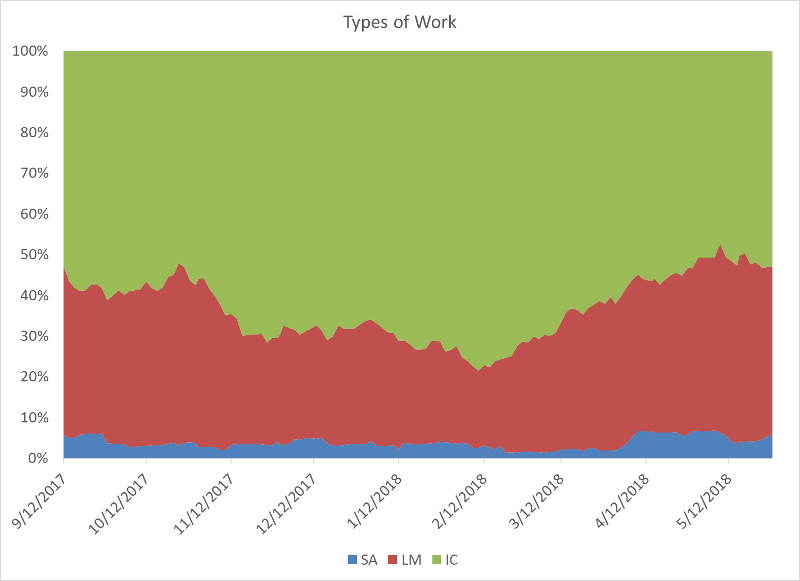
You can see when the MassLandlords employee went on leave in January, I realized I needed to change what I was doing. I spent much more time on the MassLandlords hiring process, and on our four part-time hires, and have prioritized keeping them busy. I don’t know how high I can drive the leveraged management bar, but the goal is that IC should go down to zero. If it can be hired for, we hope to hire for it.
Split Between Projects
This graph shows the split between my projects:
- “MTL 7” includes running the house and shopping for a new property (it ought to be renamed from “MTL 7” to “real estate”)
- “RH” is RentHelper
- “ML” is MassLandlords
- “Personal” is other unsorted work stuff like this blog

The real estate portion has been climbing because of the sudden vacancy, a renovation, and some open houses (maybe we’ll buy something). The real estate portion could fall back to long-term levels once the vacancy is filled if we don’t buy anything. Or we could buy a new property and it could climb.
RentHelper is not getting the attention it needs.
Overall, with the exception of the most recent week, I’m more engaged with my work than in the 2017 timeframe (more hours worked each week on average).
Expediting
In the absence of any real “stepping back” to reevaluate what I’ve been doing, I’ve resorted to the trap of expediting. In the reminder system, some things are tagged as “must happen today.” For instance, each team member gets a “must happen today” reminder to address any remaining emails or overdue tasks at least once a week; 13 ticklers are related to team members. This effectively limits the time they’re waiting for my input on routine matters; they all get expedited answers by chatting or messaging me when they need it.
The rest of the priority ticklers are almost all related to cashflow management, taxes,and billpay. These are all tedious and you would think I could eliminate them, but the consequences of a possible mess-up have prevented me from delegating these.

The final ticklers are about reinforcing priorities. For instance, I purposefully work on the MassLandlords newsletter, MassLandlords events, and RentHelper lead nurturing ahead of older items in the queue.
The problem with expediting is that the queue keeps growing. So until I can work this list of priority ticklers down to zero, we shouldn’t expect to see the task queue decrease. I briefly experimented with eliminating the team-oriented ticklers, but as I wasn’t able to stay at inbox zero, I found our team became unreasonably delayed waiting for my input. So I added them back in.
If we’re thinking about structural issues, the major issues are certainly distractions from what will drive progress. A negative example: a MassLandlords contract partner felt threatened by our ascendancy and stated they would sue us; we offered to discuss and settle, they said no. A positive example: I was invited by the City of Worcester to participate in a task force for housing-first solutions to chronic homelessness; I said yes. None of the work I do on either of those will move the needle on these graphs, but the work needed to be done, both for our long-term well-being and for the public. So it goes.
How Upwork Hobbled the Business Elance Started
Upwork was created from the merger and rebranding of Elance and Odesk, two remote-work behemoths. At the outset I was concerned. Part of it was just my usual aversion to change. Elance had allowed MassLandlords to be born and worked very well. Why change it? But now almost four years after the announcement, it’s clear that Upwork is standing in MassLandlords’ way. Here’s why I won’t send any more work to their platform.
A Business is Born
First the short history. MassLandlords was created out of a club of frugal (read: cheap) landlords. There were 20 such clubs in Massachusetts. We united the first third of them, and we have two-thirds to go.
Elance allowed us to hire our first staff position, a bookkeeper at 2 hrs/mo in April 2014. This role constituted a “micro hire” that was impossible to fill locally. Now as we’ve grown 20x, that role has grown 20x, and similarly with all our other hires. Elance was an entrepreneurial godsend. We had complete control over our hiring and selection process, our business methods, and our cost structure. We were as fast or as slow as we needed to be. We were scalable without investment. We could bootstrap. This was key for us.
Hiring Strategy and Brand
I once tried freelancing, and I found it brutally hard to compete. So MassLandlords took some steps that were unusual, that differentiated us and allowed us to find the best talent:
- We would hire for every posting. A 100% hire rate showed that we were no tire-kicker. We were serious, and worth taking the time to reply to.
- We would hire for the long-term. Every relationship we started was intended to be a permanent staff position.
- We would offer minimums. If the job didn’t provide enough work, we would pay up to some minimum because we wanted you to keep us in mind.
- We would hire slowly. Every hire would have multiple chances to correspond with us, either on or off-platform, in a real work setting, so that we could differentiate the flashy proposals from the real deals.
We followed this strategy as well as we could given the restrictions on Upwork’s platform. Much of this was stuff we handled manually. For instance the minimums when we started were accounted for in Excel and paid as bonuses.
The Last Straw
Fast forward to this spring, when Elance-turned-Upwork issued the latest in a long string of slights.
We had created a job posting for a developer. We received a lot of responses, both good and bad. Apparently Upwork or some algorithm thought we weren’t going to hire, so the posting was deactivated. Although we could still see all the proposals, we could no longer contact any of the freelancers. All of that hiring work on both sides, ours and the elancers, was trashed. Also, our reputation was permanently dinged, now less than 100% hire rate.
Big deal, right? Well, I tried to get Upwork to reactivate the posting or fix our hire rate. I was escalated a couple times. Without understanding our hiring strategy and brand, they eventually gave me a $50 credit. They didn’t give our proposal freelancers anything, despite the work they had put into applying. And they said that our 100% reputation was forever gone, completely unfixable, and that the developers wished they could help but couldn’t. I found their answer less than credible.
Here is the Last Thing I Wrote to the Highest Level of Upwork Support
Request #19039855
“Amanda,
Very pleased to meet you and thank you for the detailed and thorough response.
Since Elance was converted into Upwork, I have been increasingly uncertain whether I can rely on Upwork to build our virtual business. Here are some comments from freelancers I have worked with on your platform:
- “Upwork is a bit unpolished at the moment and seems too complicated”
- “Upwork’s fees on new projects are ridiculous!”
- “Upwork is deactivating freelancer accounts without talking to us.”
The experience from my point of view has been similar.
My first item of feedback to Upwork was, “Elance was an engineer with its sleeves rolled up. Upwork is a basset hound wearing a tie.” The site is all gloss and no guts.
Over the last 18 months, I have received 50 notification emails about idle contracts, all of which are long-term contracts that I wished to remain open. I have no ability to set a preference custom to my business. My freelancers work monthly, and every month their contracts fall idle. They are unable to log their time until I reactivate the contract.
When I log in, Upwork’s loading screen says something like, “It takes a client on average three days to hire via Upwork.” That does not describe my business. We hire slowly, for the long term. I cannot conceive of how we could make a hiring decision in so short a time. I have no ability to set a preference custom to my business.
A job posting which I specifically flagged as not to be indexed by google somehow resulted in a dozen out-of-Upwork communications, including one which was so base I reported it to the Attorney General of the State of New York. Clearly this person was not your responsibility, but the posting itself must have been seen and identified through some error.
And now, after a month’s calendar time of discussion on this one ticket:
— None of the freelancers who applied are being compensated for having to read our invite and re-submit a fresh proposal.
— Our reputation remains less than what it should be because of a unilateral decision by Upwork.
— Upwork remains presented as a finished product, for which there is no roadmap for improvement, no development, and certainly no interest in adapting to any customer’s needs.
You wrote, “I cannot imagine this would harm your ability to hire.” Well I cannot imagine why I _would_ hire on Upwork unless this issue is addressed. It is the final nuisance in a regrettably long list.
Where we might be business partners, growing MassLandlords together, I cannot help but feel expendable.
See what you can do with this. I will wait for the engineers.
Thank you for the time and effort.
Sincerely.”
I was hoping they would talk on their side and make an accommodation.
Here is what Upwork Said 30 Days Later
“I haven’t heard back from you in a few days, so I wanted to follow up to see how you’re doing with this issue. In the meantime, I’m going to mark this ticket as solved, but feel free to respond anytime if you need additional help, and this will re-open your ticket.”
Typical canned reply crap.
Alternatives to Upwork
Upwork may be huge, but fortunately, they don’t have the monopoly on finding talent. We’ve been very successful hiring remotely with craigslist, Harvest, and QuickBooks online to handle everything we valued in Upwork. Our hiring process runs the way we want it to. No one is deactivating our ability to contact our applicants.
Would I prefer to hire on Upwork again? Sure, because the truth is microhires are still harder on craigslist. But if the attitude Upwork has is “everyone should hire like we want to,” I think I’ll do my own thing. MassLandlords may have been temporarily hobbled by this issue, but it was only temporary. That developer we wanted to hire? We found them another way. It just took a little longer than we expected.
The Great Untasking (aka Truck Number ~1)
This update gives a little insight into a GTD fail and recovery.
Last November MassLandlords hired a key full-time employee. Before then, we were already heading into task-trouble. The graph below shows the terrible climax. On March 6, 2017, I had 617 items overdue. The oldest was 84 days late.
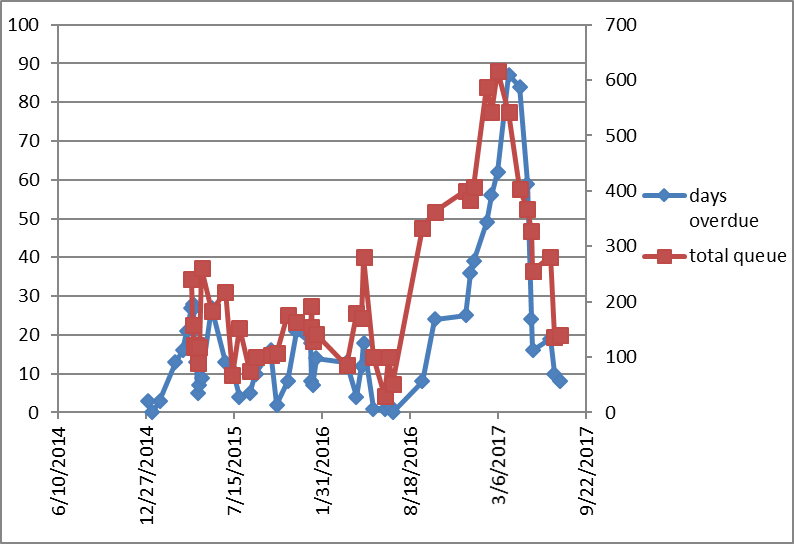
Most of these items were MassLandlords tasks, but the graph shows everything on my plate. The data points were taken when I felt I had time or energy to take data, which sometimes meant when I was feeling particularly bad or good about the situation. (If it were possible to create the graph automatically, I might have been more regular or scientific about sampling.)
When MassLandlords hired in October, I didn’t anticipate what I later came to realize: we weren’t ready to hire for that role. That key hire was great, but they exposed some weaknesses in our processes and resulted in a lot of extra work for me. We survived the last nine months with most of our customers. Most significantly, it’s now fair to approximate our truck number as slightly greater than one. We may be still be in a tenuous situation, but we are nevertheless in the best situation to date.
What’s Different?
Certainly the primary improvement was the addition of our second full time equivalent, despite the surge in tasks their new role created.
Another improvement made during this period was to start migrating all customer service responsibilities out of asana, which has no customer-service features, and into groove. Groove has put up almost no adoption hurdles for the team. It has streamlined and created a sense of perspective that was lacking before. Many tickets ran through my inbox before. I intend to remain accessible to MassLandlords members, but for their sake as much as mine, we are slowly going to start directing their communications to me through Groove. Many routine items (most common complaints: password issues, message board access) can be triaged by team members while we work to eliminate root cause. The items that need my attention can still be forwarded to me.
Another improvement was when I started prioritizing emails from team members. I do not use gmail’s priority inbox. Instead, I have a Monday priority reminder to search my inbox for messages from each team member and provide what they need. I believe that expediting is the sign of a broken process — my process is broken — but this expediting has produced managerial leverage, in the Andrew Grove sense: each hour I spend expediting frees up many hours of team member time. There are currently ten people on my leverage list, putting out 50 to 90 hours each week in total. With team members in the US, Philippines, India, Africa, and Europe, a response one hour late can result in a calendar day’s worth of delay. A sticky note on my monitor reads, “When you manage people, it’s all about them.” This is a great quote from Jack Welch, and a reminder to work towards team dynamics that don’t require me in the loop at all.
Speaking of monitor stickies, another sticky reads, “hire every day.” There are three or four essential roles still needed at MassLandlords before we can declare victory on the bootstrapping challenge. This may take another year yet. When we originally set out in late 2013, early 2014, I estimated it would be about five years to stability. We can’t yet prove me wrong.
Two more factors just in the last 30 days have resulted in a general freeing.
First, one of our most demanding and harassing customers (not a landlord but an organization) finally cut the tether holding them to reality and set sail for the great political void. I bid them adieu, and bid welcome to the newly freed timeslots on my calendar.
Second, I have had a total break from the demanding cycle of MassLandlords events. We are attempting to hire for a major event role before the 2017-2018 season begins. We also hope to reduce my attendance at some events with video. Events took up more time than I realized, and since there are no events in July or August, I have been able to close out a wide variety of tasks. There are currently 102 projects and focus areas in various states of need. Many of the projects will be closed out, and we will continue to offload focus areas as we hire.
So that’s the GTD fail and recovery. This fall, when events resume, we shall see whether I have made a lasting improvement.
What should be humanity’s top priority?
I saw a quora article by this title back in February. In it, there were various suggestions split into two main camps: either social or technological. I think humanity’s top priority is probably the intersection of the two.
Specifically, humanity’s top priority is almost certainly is the predictive ability of economics, and thereby, the application of science to government.

Many ideas were suggested in the quora article, including space colonies. How can we know which is best? Economics should come to the rescue, but it’s the “dismal science.” We cannot predict with any repeatable certainty which actions will lead to “improvement.” To make matters worse, there is serious disagreement over what to improve. Should we minimize the maximum unhappiness? Should we maximize average happiness? Should we do whatever it takes to propagate our genome, our ideas, or our individual freedoms? Should we all just seek inner enlightenment, as one person suggested?
The truth is we have only a vague idea. Our limited history gives us incomplete empirical data, very little of which was designed for statistical analysis or recorded in adequate detail. Our theories can explain some concepts and some trends very well, but when it comes to Trump’s election or ISIS we are easily blind-sided. And unlike our endeavors in the similarly complex medical sciences, we have no economic “clinical trials.” There is almost no deliberate experimentation in government or society. There is little candor in evaluating the results of what little we try.
I suspect that we will be able to decide the next “top priority” — and eliminate political divisiveness in the process — if we can first beef up economics. There are two components to this: economic “clinical trials” and better predictive modeling.
Imagine you could take a proposed law and run it forward 100 years in a simulator. What does that do to the target objective? What externalities do we see? Does the simulation suggest a refinement or an altogether different approach?
Meanwhile, for things that are harder to predict, can we voluntarily enlist 100,000 people in an economic trial? One group is a control, the other group lives under slightly different circumstances.
With either approach, there are daunting implementation details to be worked out. Modeling is sharply limited by our understanding of human behavior and our computational inability to simulate anything as complex as a society. And economic trials are going to be befuddled by selection bias, and double-blind issues, and all the ethical questions delineating the degree to which we experiment on ourselves.
But in principle, this is the approach. We have used it with astonishing success in mechanical engineering, which is the application of science to solving hard physical problems. We should apply similar methods to social engineering. Politics as a method leaves me feeling misdirected, to say the least.
My hope is that we can — with modeling and economic trials — expand the scientific method to the work of government. Rallied around an objective reality, anything will be possible. Divided along untestable ideological lines, we can only hope to muddle our way forward.
So science in government first. Space colonies later, if that’s what makes sense.
Bootstrapped Startup Update: Leveraged Management vs Individual Contributions
Starting 18 months ago, I began more detailed timetracking for MassLandlords, which is a bootstrapped startup. I started noting the difference between what Andrew Grove called “high leverage” activities and what Pratt and Whitney called “individual contributor” activities. This is the first time I’ve made a graph of the results. It’s a prime example of “what you don’t measure doesn’t get better.” It shows that I haven’t been unburying myself the way I imagined.

The graph shows percent “level of effort” (what percent of time I spend on just these two activities) vs time. Each point is four days’ worth of time data, averaged over the last 40 days so it looks smoother. I track my time in four-day intervals because I use a piece of paper on a clipboard that I keep with me at all times, because only four days fit on a sheet, and because weekends are not very relevant anyway =(. I quickly note what I’m doing on paper. I don’t need to use any company-specific information systems like harvest, where maybe I’m not logged in or I need to switch accounts or who knows what is going wrong. (I love harvest for team-level perspectives, but paper is like harvest just for me.)
The blue portion represents time spent doing “leveraged management.” The idea is that one or two hours spent with a direct report, employee, or contractor will enable them to do eight or more hours of work on their own. In the last 18 months, MassLandlords has brought on about 50 hours of work each week (one big and several smaller hires). So I somewhat expected that I would add about ten hours of high leveraged work each week and lose a lot of unleveraged work. The red portion of the graph is “individual contributor,” or things that an employee should be hired to do.
The new hires are definitely working out, but they are exposing weaknesses in customer service, event logistics, and financial controls. All of these areas are largely my “individual contributor” responsibility. On our bootstrapped trajectory, it has been undesirable to lose touch with our customers by hiring for service, and impossible to hire adequately for logistics or controls (these positions seem to require some degree of scale because of the physical nature of the logistics work, and great degree of trust required to hand over financial controls). The increased effort for event marketing, event planning, and advertising have certainly been helpful, but they are generating more customer interactions, more events, and more transactions.
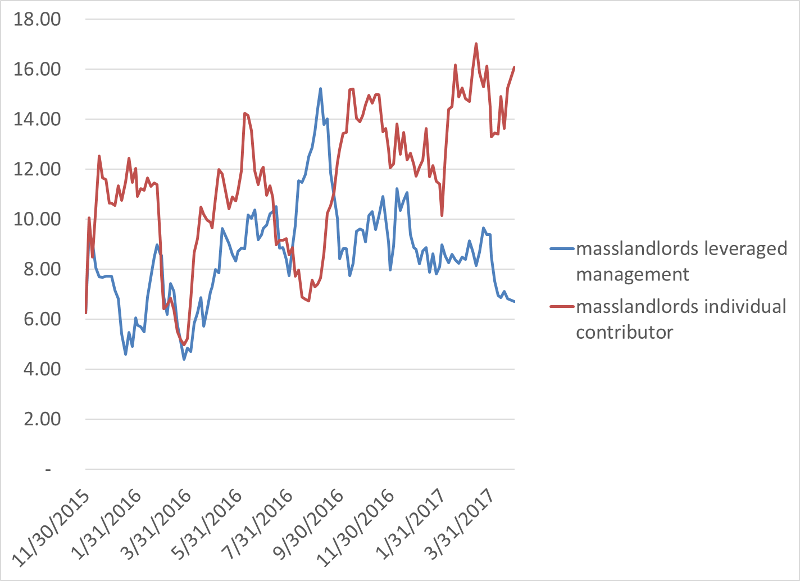
The graph showing total hours gives more insight. The red “individual contributor” line has been climbing as MassLandlords has grown. Our major hire started fall 2016. During their training, the blue “leveraged management” line spiked. It has been declining as they (and other team members) gain experience and ability. The blue line should have stayed high after that major hire. Except with the weaknesses in service, logistics, and controls, the red line shows a lot has landed back on my plate. This has distracted me from focusing on scaling and the next hire.
The trick here seems to be to make sure that some portion of the blue line includes time spent scaling and focusing on the next hire. If that’s the case, then we will eventually successfully pull ourselves up by the bootstraps. On the other hand, if the blue line is being spent just to keep the existing team going, then we must be caught in limbo. Not only will no one be working on scaling, but also, because I am just one person, the red line will eventually max out, customers will go unhappy, churn will increase, and the organization will rebound downward. Understanding this graph is of the first importance. And anyone with a bootstrapped startup probably should be making their own graph, because so much of starting up is “the grind” that produces so little value compared to high-leverage activities.
Random Grumbles and Advice
Service: Knowing what I know now, I would have implemented a customer service process much sooner, maybe at the outset. It would have been possible for me to maintain contact with customers even from inside a framework like zendesk. Now we have a situation where customers are emailing the last team email address they saw, which is pretty much not working out for anyone.
Controls: I also would have prioritized a relationship with a bank that gave granular access controls. Most small business banks — and even quickbooks online, which I otherwise much admire — have laughable separation of controls. The person who enters vendors must not be the person who pays them, and this must not be the person who records the debts in the first place. Most small business systems make all of this accessible to the same user. Thereby, any dishonest schmuck can enter a fake vendor bill, enter the fake vendor billpay, and pay the fake bill to themselves or to their cousin. Sure, they will eventually get caught, but only after much stress and financial loss on our side. I think Avidia Bank will be our partial salvation but until we implement it, I can’t say for sure. QuickBooks online is still not compliant, and I don’t see a way around that yet, so we’re waiting to hire an employee who can be paid enough to come with high “trust factor.”
Logistics: This is a problem particular to MassLandlords, where we basically need to have 23 physical locations one night a month. I don’t think I have any insight to share at this time.
So that’s the latest timetracking update on our bootstrapped startup. I see now why people take capital: just go hire all the people you need.
Prioritization Grid
I drew this on a screenshare today while talking to a MassLandlords manager.

I don’t remember where I learned it*. The basic gist is that lots of people will suggest lots of things for you to do.
Some things are going to be hard and have a low impact on your goals. Write them down, but don’t do them.
- These might become more relevant or less difficult in the future.
- Writing them down, as opposed to outright rejecting them, lets you return to them in the future. It also is more politically palatable to a requester to hear that it’s in your system, albeit lower priority, than “I have deleted your request.”
Others are going to be easy, low impact. Most administration falls into this category. Hire for it if you can. If you’re not able to hire, do these items when you’re tired.
- Anna Dietrich described these items as “zombie tasks” or “shooting zombies” because they are repetitive and won’t ever die. I like that analogy.
- When possible, try to eliminate the source of the zombies. Automation or process changes can eliminate a lot of the low impact work we take as given.
Some things are easy and will have a high impact on your goals. Do these asap.
- This is the most difficult thing for someone detail-oriented like me to do. I like to have a clean desk and inbox zero. Much of my best work happens because I ignore the other pressures.
The final set are things that will have a high impact but are hard. These require project plans and a longer-term commitment.
- It’s extremely important not to let a “high impact” item linger because you haven’t created the project plan. Oftentimes the first “action” is a brainstorm or research. Get these items into your task list. David Allen’s advice is invaluable on this front. Define the next action. The journey of a thousand miles begins with a single step.
I don’t like spending lots of time bucketing items into different categories. I don’t like systems that have nine or 16 squares. This four-square framework can be useful for communicating when you will or will not work on something. Otherwise, just get back to work.
*Covey’s Original Prioritization Framework
It turns out Stephen Covey popularized this, but he didn’t have “difficulty,” he had “urgency.” This switch hides any recognition that management or project planning might be needed. I might have learned to replace “urgency” with “difficulty” at Pratt & Whitney, I don’t know. Suffice it to say I think of the grid above when I think of priority frameworks.
Thinking of “urgency” works better in the “personal productivity” space, but less well in organizations. Everything is urgent to the requester.
Why is the law so hard to read?
If I could wave a magic wand, I would pass a law that read,
“Every law must be comprehensible by the people it is meant to govern.”
and then I would pass another law that read,
“For the purpose of the law, attorneys are presumed to have infinite intellect, and can punish themselves with whatever legalese in law or regulation they so desire to inflict upon their own profession, but may so punish no one else.”
That way, everyone’s in heaven.

